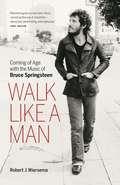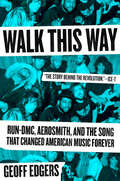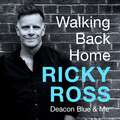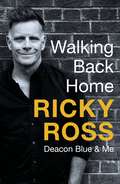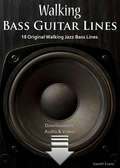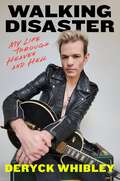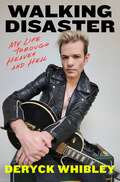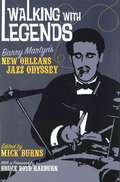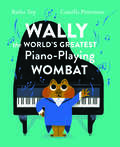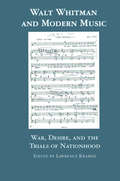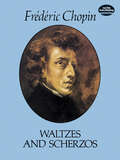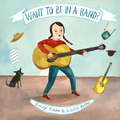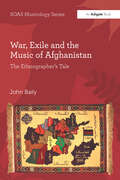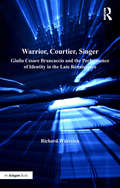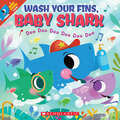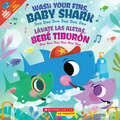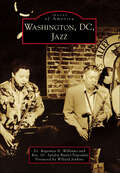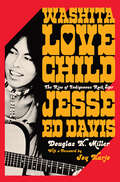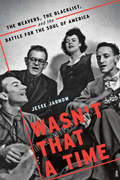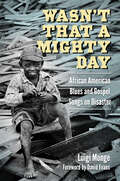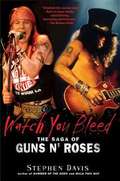- Table View
- List View
Walk Like a Man
by Robert J. WiersemaThere are dozens of books about the Boss, exploring every facet of his career. So what's left to say? Nothing objective, perhaps. But when it comes to music, objectivity is highly overrated. Robert Wiersema has been a Springsteen fan since he was a teenager. By most definitions, he's a fanatic: following tours to see multiple shows in a row, watching set lists develop in real time via the Internet, ordering bootlegs from shady vendors in Italy. His attachment is deeper than fandom, though: he's grown up with Springsteen's music as the soundtrack to his life, beginning with his working-class youth in rural British Columbia and continuing on through dreams of escape, falling in love, and becoming a father.Walk Like a Man is liner notes for a mix tape, a frank and inventive blend of biography, music criticism, and memoir over the course of thirteen tracks. Like the best mix tapes, it balances joy and sorrow, laughter seasoning the dark-night-of-the-soul questions that haunt us all. Wiersema's book is the story of a man becoming a man (despite getting a little lost along the way), and of the man and the music that have accompanied him on his journey.
Walk This Way: Run-DMC, Aerosmith, and the Song that Changed American Music Forever
by Geoff EdgersWashington Post national arts reporter Geoff Edgers takes a deep dive into the story behind “Walk This Way,” Aerosmith and Run-DMC's legendary, groundbreaking mashup that forever changed music. The early 1980s were an exciting time for music. Hair metal bands were selling out stadiums, while clubs and house parties in New York City had spawned a new genre of music. At the time, though, hip hop's reach was limited, an art form largely ignored by mainstream radio deejays and the rock-obsessed MTV network.But in 1986, the music world was irrevocably changed when Run-DMC covered Aerosmith's hit “Walk This Way” in the first rock-hip hop collaboration. Others had tried melding styles. This was different, as a pair of iconic arena rockers and the young kings of hip hop shared a studio and started a revolution. The result: Something totally new and instantly popular. Most importantly, "Walk This Way" would be the first rap song to be played on mainstream rock radio. In Walk This Way, Geoff Edgers sets the scene for this unlikely union of rockers and MCs, a mashup that both revived Aerosmith and catapulted hip hop into the mainstream. He tracks the paths of the main artists—Steven Tyler, Joe Perry, Joseph “Run” Simmons, and Darryl “DMC” McDaniels—along with other major players on the scene across their lives and careers, illustrating the long road to the revolutionary marriage of rock and hip hop. Deeply researched and written in cinematic style, this music history is a must-read for fans of hip hop, rock, and everything in between.
Walking Back Home
by Ricky RossThe first memoir by Deacon Blue singer and music icon Ricky Ross.In 1986, Ricky Ross started a full-time career in music, which has lasted for over 35 years. His earlier working life was spent in youth work and teaching in his home city of Dundee, and his adopted home of Glasgow. It was in these two cities where he spent his formative years learning how to write and play songs. Having always written about the people and places who've made an impact on his life, it's no surprise that this is how he has approached Walking Back Home, his first ever memoir, which takes the reader on a journey from Ricky's childhood to the rollercoaster of leading his band Deacon Blue to top of the charts and the band's eventual break-up and his solo career. 'I started to write about the years I spent putting the band together, on the first time we ever played in America, and about some of the musical characters I've met along the way. I gave some thought to growing up in suburban Dundee in a family with no record player and no sense that someone like me could, one day, make a record. That's one part of the story. However, I still want to talk about the smell of Born To Run when I first got it home and how I saw the Buzzcocks looking at a Cliff Richard album sleeve in a Dundee Record Shop window. I still want to tell the stories of my Grandparents and parents and the woman whose voice was so vulnerable when she got up to sing at our church.For all these years I've told stories. Sometimes these days I also tell them on the radio. I've met some amazing people and their stories need told too. The first time Deacon Blue ever played Wembley Arena I started to introduce a song only to hear, 'Get on with it' shouted from Row Z. We proceeded with the song, but I often thought I'd quite like to finish that story.'(P) 2022 Headline Publishing Group Ltd
Walking Back Home
by Ricky Ross'For all these years I've told stories. Sometimes these days I also tell them on the radio. I've met some amazing people and their stories need told too. The first time Deacon Blue ever played Wembley Arena I started to introduce a song only to hear, "Get on with it" shouted from Row Z. We proceeded with the song, but I often thought I'd quite like to finish that story.'In 1986, Ricky Ross started a full-time career in music, which has lasted for over 35 years. His earlier working life was spent in youth work and teaching in his home city of Dundee, and his adopted home of Glasgow. It was in these two cities where he spent his formative years learning how to write and play songs. Having always written about the people and places who've made an impact on his life, it's no surprise that this is how he has approached Walking Back Home, his first ever memoir, which takes the reader on a journey from Ricky's childhood to the rollercoaster of leading his band to top of the charts and their break-up, his solo career and Deacon Blue's recent renaissance.
Walking Back Home
by Ricky Ross'For all these years I've told stories. Sometimes these days I also tell them on the radio. I've met some amazing people and their stories need told too. The first time Deacon Blue ever played Wembley Arena I started to introduce a song only to hear, "Get on with it" shouted from Row Z. We proceeded with the song, but I often thought I'd quite like to finish that story.'In 1986, Ricky Ross started a full-time career in music, which has lasted for over 35 years. His earlier working life was spent in youth work and teaching in his home city of Dundee, and his adopted home of Glasgow. It was in these two cities where he spent his formative years learning how to write and play songs. Having always written about the people and places who've made an impact on his life, it's no surprise that this is how he has approached Walking Back Home, his first ever memoir, which takes the reader on a journey from Ricky's childhood to the rollercoaster of leading his band to top of the charts and their break-up, his solo career and Deacon Blue's recent renaissance.
Walking Bass Guitar Lines: 15 Original Walking Jazz Bass Lines with Audio & Video (Bass Guitar Lines #2)
by Gareth Evans15 Original Walking Bass Guitar lines in tablature and notation for the intermediate to advanced bassist. >> 176 bars of music over 15 Bass lines (average Bass line length 11.7 bars) >> Audio demonstrations and backing tracks for each Bass line at slow (70bpm), medium (135bpm) and fast (200bpm) speeds with video demonstrations for medium speed (Downloadable). >> Each Bass line includes an interval analysis of all of its notes and theory explanations of various approaches to chord changes. Please Note: This eBook has written music and is not suitable for smaller screens.
Walking Disaster
by Deryck WhibleyThis candid memoir of punk rock, fame, and endurance from Deryck Whibley, lead singer of Sum 41, follows Whibley's rise from a punk kid in Canada to an international star.From his earliest days as a kid in Canada, Deryck Whibley was a punk who loved music and couldn't wait to achieve something bigger and better than the humble path that lay before him. Raised by a single mom and constantly moving from place to place, Deryck was used to being the new kid, starting fights (or finishing them), and finding friends who shared his sensibility for chaotic fun and loud music. Sum 41 was born of a group of friends who loved to jam, shared a DIY ethos, and were determined to be rock stars one day.Walking Disaster is Deryck's story, but it is also the untold story of Sum 41. Deryck takes you backstage, into the recording booth, and through the highest highs and lowest lows of the band whose story is inextricably woven with his own.With his insightful, earnest, and genuine voice, Deryck gets real about fame, fortune, and the music industry. From winning at the MTV Video Music Awards, being nominated for a Grammy, his high-profile relationships and friendships, contending with invasive paparazzi, and suffering from health issues that brought him to the brink, Deryck offers a forthright and unforgettable memoir.
Walking Disaster: My Life Through Heaven and Hell
by Deryck WhibleyThis candid memoir of music, fame, and endurance from Deryck Whibley, lead singer of Sum 41, follows his rise from a punk kid to an international star. From his earliest days growing up in Canada, Deryck Whibley was a punk who loved music and couldn&’t wait to achieve something bigger and better than the humble path that lay before him. Whibley was raised by a single mom and their small family constantly moved from place to place, so he was used to being the new kid, starting fights (or finishing them), and connecting with people who shared his sensibility for chaotic fun and loud music. Sum 41 was born of a group of friends who loved to jam, shared a DIY ethos, and were determined to be rock stars one day. Walking Disaster is Whibley&’s story, but it is also the untold story of Sum 41. Whibley takes you backstage, into the recording booth, and through the highest highs and lowest lows of the band whose story is inextricably woven with his own. With his insightful, earnest, and genuine voice, Whibley gets real about fame, fortune, and the music industry. Detailing everything from winning at the MTV Video Music Awards and being nominated for a Grammy to revisiting his high-profile relationships and friendships, contending with invasive paparazzi, and suffering from health issues that brought him to the brink, Whibley offers a forthright and unforgettable memoir.
Walking with Legends: Barry Martyn's New Orleans Jazz Odyssey
by Mick Burns Bruce Boyd RaeburnDrummer, record producer, bandleader, jazz researcher, and cigar-chomping raconteur Barry Martyn is a New Orleans original who happens to have been born in England. Implausible though this may seem, it makes perfect sense to members of the New Orleans traditional jazz community, who view themselves as an extended family based on merit as much as nativity. For more than forty years, Martyn has been a fixture in the Crescent City's jazz scene, laying down the beat for generations of celebrated musicians and avidly promoting the city's unique musical heritage around the world. In Walking with Legends -- based on over forty hours of interviews with Martyn by fellow British jazz enthusiast and author Mick Burns -- Martyn reflects upon his life in jazz and offers a window into a musical world that few have understood, let alone witnessed from the inside. At the age of nineteen, jazz fanatic Martyn found his way to the Crescent City and began working as a professional drummer in clubs and studios. The first white man in the United States to join a black musician's union, he eventually started his own record label and recorded hundreds of jam sessions that today are regarded as classics in Europe. In 1972, he formed the Legends of Jazz, an old-style New Orleans jazz band that toured the world and took New Orleans jazz into the American showbiz mainstream.Martyn's life story provides unique intimate glimpses of a vanished generation of New Orleans musicians, including Louis Armstrong, Kid Sheik Cola, Harold Dejan, Joe Watkins, Albert Nicholas, Kid Thomas, Andrew Blakeney, and many others. Throughout his chronicle, Martyn highlights the continual clash of cultures that arose from an avid British pupil learning lessons of life and music from elderly African American strangers who take him under their wing both out of curiosity and self-interest. Together, they find a way to connect through music, even if the road gets a little bumpy at times. A standard-bearer for New Orleans's jazz drumming tradition, Martyn remains one of the city's busiest musicians and most avid promoters of New Orleans music. In Walking with Legends, he honors the legacies of the African American musicians who taught and inspired him and affirms the importance of the human relationships that make the music possible.
Wally the World's Greatest Piano-Playing Wombat
by Ratha TepWally was the world's greatest piano-playing wombat—until he realized there was an even more talented piano-playing wombat in town! This funny picture book's bright colors and imaginative musical scenes teach children to have self-confidence when faced with competition. When Wally, the world's greatest piano-playing wombat, hears Wylie play, he becomes envious. Wally tries toe-tapping and ball-twirling as he plays piano, but every time Wally thinks he's one-upping the competition, he discovers Wylie can do all the same tricks. Although Wally is discouraged at first, he soon realizes that competing with Wylie inspires them both to play better. And finding a friend to share what you love? That's the best win of all. Both affirming and motivating, Wally's story will resonate with young readers as they learn how to deal with competition and to do what makes them happy—even when they're not the very best.
Walt Whitman and Modern Music: War, Desire, and the Trials of Nationhood (Border Crossings #Vol. 10)
by Lawrence KramerWalt Whitman's poetry, especially his Civil War poetry, attracted settings by a wide variety of modern composers in both English- and German-speaking countries. The essays in this volume trace the transformation of Whitman's nineteenth-century texts into vehicles for confronting twentieth-century problems-aesthetic, social, and political. The contributors pay careful attention to music and poetry alike in examining how the Whitman settings become exemplary means of dealing with both the tragic and utopian faces of modernism. The book is accompanied by a CD recording by Joan Heller and Thomas Stumpf of complete Whitman cycles composed by Kurt Weill, George Crumb, and Lawrence Kramer, and the first recording of four Whitman songs composed in the 1920s by Marc Blitzstein.
Waltzes and Scherzos (Dover Classical Piano Music)
by Frédéric ChopinSparkling, graceful and tinged with an ineffable melancholy, Chopin's waltzes succeed in conveying an air of mystery while retaining their ballroom splendor. His scherzos are truly novel metamorphoses of the form -- tumultuous emotional outpourings that frequently attain tragic heights. Prepared by Carl Mikuli, Chopin's student and teaching assistant, this edition of these innovative works is particularly authoritative, reflecting Mikuli's knowledge and understanding of Chopin's music. This volume includes: Waltzes Op. 18 Op. 70, Nos. 1-3 Op. 34, Nos. 1-3 E Minor, (Op. posth.) Op. 42 E Major (Op. posth.) Op. 64, Nos. 1-3 Op. 69, Nos. 1-2 Scherzos Opp. 20, 31, 39, 54 Republication of works from an authoritative early edition. New unified table of contents.
Want to Be in a Band?
by Giselle Potter Suzzy RocheDo you want to be in a band? Well, here's how! First, bug your two older sisters to start a band, and then beg them to join. (It helps if they already know how to sing and play guitar.) Then there are some tricky parts, like getting over STAGEFRIGHT and practicing until the tips of your fingers ache and playing gigs at not-so-big-time music clubs. At least, that's the way our little sister narrator explains it in her "guide" on how to start a band, based on the real-life experiences of author Suzzy Roche.From the Hardcover edition.
War and Death in the Music of George Crumb: A Crisis of Collective Memory (Ashgate Studies in Theory and Analysis of Music After 1900)
by Abigail ShupeThis book studies George Crumb’s The Winds of Destiny (2004) and Black Angels (1970) as artifacts of collective memory and cultural trauma. It situates these two pieces in Crumb’s output and unpacks the complex methodologies needed to understand these pieces as contributions and challenges to traditional narratives of the Civil War and the Vietnam War. The Winds of Destiny is shown to be a critical commentary on the legacy of American wars and militarism, both concepts crucial to American identity. The Winds of Destiny also acts as an ironic war memorial as a means of critiquing such concepts. Black Angels has long been associated with the Vietnam War. This book shows how this association began and how it endures through connections to iconic Vietnam War media, including films and books. Together these analyses show the legacy of trauma in American collective memory, which is in a continuous crisis. Crumb’s musical critiques point to a need to resist conventional narratives and to begin to heal trauma on a collective level. This book will be of interest to students of contemporary American music, American studies, and memory studies. It benefits readers by newly situating Crumb’s music within these three fields of study.
War, Exile and the Music of Afghanistan: The Ethnographer’s Tale (SOAS Studies in Music)
by John BailyIn the 1970s John Baily conducted extensive ethnomusicological research in Afghanistan, principally in the city of Herat but also in Kabul. Then, with Taraki’s coup in 1978, came conflict, war, and the dispersal of many musicians to locations far and wide. This new publication is the culmination of Baily’s further research on Afghan music over the 35 years that followed. This took him to Afghanistan, Pakistan, Iran, the USA, Australia and parts of Europe - London, Hamburg and Dublin. Arranged chronologically, the narrative traces the sequence of political events - from 1978, through the Soviet invasion, to the coming of the Taliban and, finally, the aftermath of the US-led invasion in 2001. He examines the effects of the ever-changing situation on the lives and works of Afghan musicians, following individual musicians in fascinating detail. At the heart of his analysis are privileged vignettes of ten musical personalities - some of friends, and some newly discovered. The result is a remarkable personal memoir by an eminent ethnomusicologist known for his deep commitment to Afghanistan, Afghan musicians and Afghan musical culture. John Baily is also an ethnographic filmmaker. Four of his films relating to his research are included on the downloadable resources that accompanies the text.
Warrior, Courtier, Singer: Giulio Cesare Brancaccio and the Performance of Identity in the Late Renaissance
by Richard WistreichGiulio Cesare Brancaccio was a Neapolitan nobleman with long practical experience of military life, first in the service of Charles V and later as both soldier and courtier in France and then at the court of Alfonso II d'Este at Ferrara. He was also a virtuoso bass singer whose performances were praised by both Tasso and Guarini - he was even for a while the only male member of the famous Ferrarese court Concerto delle dame, who established a legendary reputation during the 1580s. Richard Wistreich examines Brancaccio's life in detail and from this it becomes possible to consider the mental and social world of a warrior and courtier with musical skills in a broader context. A wide-ranging study of bass singing in sixteenth- and early seventeenth-century Italy provides a contextual basis from which to consider Brancaccio's reputation as a performer. Wistreich illustrates the use of music in the process of 'self-fashioning' and the role of performance of all kinds in the construction of male noble identity within court culture, including the nature and currency of honour, chivalric virtù and sixteenth-century notions of gender and virility in relation to musical performance. This fascinating examination of Brancaccio's social world significantly expands our understanding of noble culture in both France and Italy during the sixteenth century, and the place of music-making within it.
Warum Musik in unseren Genen liegt
by Jörn Bullerdiek Christine SüßmuthWussten Sie, warum Johann Sebastian Bach ganz legal lange Finger machte? Und was Sie alles mit einer Haarlocke Mozarts anfangen könnten, wenn Sie sie besäßen? Beides könnte Sie auf die Spur eines uralten Geheimnisses bringen, nämlich warum Menschen Freude am „Hervorbringen musikalischer Töne“ haben, wie Darwin es formulierte. Liegt das wortwörtlich in unserer DNA und was hat es dort zu suchen? Die Autoren sind in gefährlicher Nähe am Felsen der Sirenen vorbei gesegelt und haben Orpheus in die Unterwelt begleitet. Sie haben den Weg von Schallwellen von ihrer Quelle bis zum Gehirn der Hörenden verfolgt und ebenso den Stammbaum der Familie Bach wie den Gesang von Zebrafinken analysiert. Schließlich sind sie nicht nur in den Sonderzug nach Pankow gestiegen, sondern haben auch noch die Caprifischer in ihrer Heimat aufgesucht. Alles in allem ist eine unterhaltsame und informative Analyse dessen entstanden, was vom alten Ägypten bis in heutige Zeit die Faszination von Musik im Spiegel unserer Gene ausmacht.
Wash Day
by Barbara H. ColeEvery wash day Miss Ett does the laundry while Grandpa keeps the children entertained by telling stories about his army days. As he plays his trumpet, they march around in time and sing along to the music. Set during the Great Depression, Wash Day tells the tale of Grandpa passing on his trumpet and his love of music to the next generation. Wash Day is a touching story about the way love and friendship can overcome the barriers of age and race to bring joy and strength to everyone.
Wash Your Fins, Baby Shark (Baby Shark)
by John John BajetSing and dance along with Baby Shark, in this catchy tune all about hand washing!Sing, dance, and read along to this brand-new song as Baby Shark and the whole shark family washes their fins! A fun tool for kids and caregivers alike, this story will have little ones singing along to the important steps of hand-washing, from squirting soap, lathering up, and drying off. Hand-washing will fly by as you sing along at home or at school, and this catchy tune is sure to help little ones remember the hand-washing steps and make sure they're washing for the right amount of time. Featuring a step-by-step guide for little hands and cleanliness tips from Baby Shark, this fun story has eye-popping illustrations and a tune you won't be able to stop singing. A must-have for every home!
Wash Your Fins, Baby Shark / Lávate las aletas, Bebé Tiburón (Baby Shark)
by John John BajetSing and dance along with Baby Shark, in this catchy tune all about hand washing!¡Canta, baila y lee con esta canción nuevecita mientras Bebé Tiburón y toda su familia se lavan las aletas! Esta historia es una divertida herramienta tanto para los niños como para los cuidadores, y hará que los pequeños canten mientras se lavan las manos, desde que se enjabonan hasta que se secan. El tiempo pasará volando mientras cantan, en casa o en la escuela, y esta melodía pegadiza hará a los pequeños recordar los pasos para lavarse las manos y garantizará que le dediquen a esto el tiempo correcto. Esta historia presenta una guía paso a paso con consejos de Bebé Tiburón para tener limpias las pequeñas manos, con ilustraciones llamativas y una melodía que no podrán parar de cantar. ¡Algo imprescindible para todos los hogares!Sing, dance, and read along to this brand-new song as Baby Shark and the whole shark family washes their fins! A fun tool for kids and caregivers alike, this story will have little ones singing along to the important steps of hand-washing, from squirting soap, lathering up, and drying off. Hand-washing will fly by as you sing along at home or at school, and this catchy tune is sure to help little ones remember the hand-washing steps and make sure they're washing for the right amount of time. Featuring a step-by-step guide for little hands and cleanliness tips from Baby Shark, this fun story has eye-popping illustrations and a tune you won't be able to stop signing. A must-have for every home!
Washington, DC, Jazz (Images of America)
by Regennia N. WilliamsWashington, DC, Jazz focuses, primarily, on the history of straight-ahead jazz, using oral histories, materials from the William P. Gottlieb Collection at the Library of Congress, the Felix E. Grant Jazz Archives at the University of the District of Columbia, and Smithsonian Jazz.Home to "Black Broadway" and the Howard Theatre in the Greater U Street area, Washington, DC, has long been associated with American jazz. Duke Ellington and Billy Eckstine launched their careers there in the early 20th century. Decades later, Shirley Horn and Buck Hill would follow their leads, and DC's "jazz millennials" include graduates of the Duke Ellington School of the Arts. For years, Bohemian Caverns and One Step Down were among the clubs serving as gathering places for producers and consumers of jazz, even as Rusty Hassan and other programmers used radio to promote the music. This volume also features the work of photographers Nathaniel Rhodes, Michael Wilderman, and Lawrence A. Randall.
Washita Love Child: The Rise of Indigenous Rock Star Jesse Ed Davis
by Douglas K. Miller“I first met Jesse Ed Davis in the late ’80s. . . . [He was a] gentle yet intensely present giant who was a legend of an artist. . . . In Washita Love Child, Jesse Ed Davis is resurrected in story.” —Joy Harjo, from the foreword No one played like Jesse Ed Davis. One of the most sought-after guitarists of the late 1960s and ’70s, Davis appeared alongside the era’s greatest stars—John Lennon and Mick Jagger, B.B. King and Bob Dylan—and contributed to dozens of major releases, including numerous top-ten albums and singles, and records by artists as distinct as Johnny Cash, Taj Mahal, and Cher. But Davis, whose name has nearly disappeared from the annals of rock and roll history, was more than just the most versatile session guitarist of the decade. A multitalented musician who paired bright flourishes with soulful melodies, Davis transformed our idea of what rock music could be and, crucially, who could make it. At a time when few other Indigenous artists appeared on concert stages, radio waves, or record store walls, in a century often depicted as a period of decline for Native Americans, Davis and his Kiowa, Comanche, Cheyenne, Seminole, and Mvskoke relatives demonstrated new possibilities for Native people. Weaving together more than a hundred interviews with Davis’s bandmates, family members, friends, and peers—among them Jackson Browne, Bonnie Raitt, and Robbie Robertson—Washita Love Child powerfully reconstructs Davis’s extraordinary life and career, taking us from his childhood in Oklahoma to his first major gig backing rockabilly star Conway Twitty, and from his dramatic performance at George Harrison’s 1971 Concert for Bangladesh to his years with John Trudell and the Grafitti Man band. In Davis’s story, a post-Beatles Lennon especially emerges as a kindred soul and creative partner. Yet Davis never fully recovered from Lennon’s sudden passing, meeting his own tragic demise just eight years later. With a foreword by former poet laureate Joy Harjo, who collaborated with Davis near the end of his life, Washita Love Child thoroughly and finally restores the “red dirt boogie brother” to his rightful place in rock history, cementing his legacy for generations to come.
Wasn't That a Time: The Weavers, the Blacklist, and the Battle for the Soul of America
by Jesse JarnowThe dramatic untold story of the Weavers, the hit-making folk-pop quartet destroyed with the aid of the United States government--and who changed the world, anyway Following a series of top-ten hits that became instant American standards, the Weavers dissolved at the height of their fame. Wasn't That a Time: The Weavers, the Blacklist, and the Battle for the Soul of America details the remarkable rise of Pete Seeger's unlikely band of folk heroes, from basement hootenannies to the top of the charts, and the harassment campaign that brought them down. Exploring how a pop group's harmonies might be heard as a threat worthy of decades of investigation by the FBI, Wasn't That a Time turns the black-and-white 1950s into vivid color, using the Weavers to illuminate a dark and complex period of American history. With origins in the radical folk collective the Almanac Singers and the ambitious People's Songs, the singing activists in the Weavers set out to change the world with songs as their weapons, pioneering the use of music as a transformative political organizing tool. Using previously unseen journals and letters, unreleased recordings, once-secret government documents, and other archival research, Jesse Jarnow uncovers the immense hopes, incredible pressures, and daily struggles of the four distinct and often unharmonious personalities at the heart of the Weavers.In an era defined by a sharp political divide that feels all too familiar, the Weavers became heroes. With a class- and race-conscious global vision that now makes them seem like time travelers from the twenty-first century, the Weavers became a direct influence on a generation of musicians and listeners, teaching the power of eclectic songs and joyous, participatory harmonies.
Wasn’t That a Mighty Day: African American Blues and Gospel Songs on Disaster (American Made Music Series)
by Luigi MongeWinner of the 2023 Award for Excellence for Best History in the category of Best Historical Research in Recorded Blues, R&B, Gospel, Hip Hop, or Soul Music from the Association for Recorded Sound CollectionsWasn’t That a Mighty Day: African American Blues and Gospel Songs on Disaster takes a comprehensive look at sacred and secular disaster songs, shining a spotlight on their historical and cultural importance. Featuring newly transcribed lyrics, the book offers sustained attention to how both Black and white communities responded to many of the tragic events that occurred before the mid-1950s. Through detailed textual analysis, Luigi Monge explores songs on natural disasters (hurricanes, floods, tornadoes, and earthquakes); accidental disasters (sinkings, fires, train wrecks, explosions, and air disasters); and infestations, epidemics, and diseases (the boll weevil, the jake leg, and influenza). Analyzed songs cover some of the most well-known disasters of the time period from the sinking of the Titanic and the 1930 Drought to the Hindenburg accident, and more. Thirty previously unreleased African American disaster songs appear in this volume for the first time, revealing their pertinence to the relevant disasters. By comparing the song lyrics to critical moments in history, Monge is able to explore how deeply and directly these catastrophes affected Black communities; how African Americans in general, and blues and gospel singers in particular, faced and reacted to disaster; whether these collective tragedies prompted different reactions among white people and, if so, why; and more broadly, how the role of memory in recounting and commenting on historical and cultural facts shaped African American society from 1879 to 1955.
Watch You Bleed
by Stephen DavisWith 90 million of the band's records sold worldwide since 1987, Guns N' Roses prolonged rock music past its sell by date with controversial albums and immense, often riotous world tours. But the band's complete story has never been fully told - until now. In his sixth major rock biography, Stephen Davis - author of the legendary Hammer of the Gods - details the riveting story of a band that originated in the gutters of Sunset Strip and went on to become the biggest, baddest band on the planet. Davis brilliantly captures the birth of Guns' raw power, which - despite rape charges, drug-induced rampages, and a general appetite for destruction - launched the band into the pantheon of rock gods such as Led Zeppelin and the Rolling Stones. With a wealth of detail, Davis looks at Axl's unrelenting quest to release the long-awaited, mystery shrouded Chinese Democracy album, as well as the further adventures of some of the Gunners under the banner of the hard-rocking band Velvet Revolver. In Watch You Bleed, for the first time, millions of Guns N' Roses fans will learn the whole truth - sometime funny, sometimes tragic - about the last of the great rock bands.
